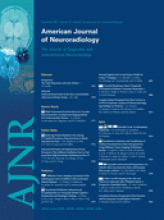Abstract
BACKGROUND AND PURPOSE: Flow-diverter stents are an alternative treatment for challenging and recurrent aneurysms. Thrombosis of the sac is thought to induce perianeurysmal brain inflammation, but such phenomena have never been studied in flow-diverter devices. We developed imaging data to explain the clinical exacerbation of symptoms after flow-diversion treatment.
MATERIALS AND METHODS: Seventeen patients with unruptured aneurysms were treated by using a flow-diverter device. Clinical symptoms and angiographic and MR imaging features were recorded before and after treatment, during both the acute and chronic phases, to look for inflammatory reaction.
RESULTS: Seven of the 17 patients (41%) showed a delayed clinical aggravation of symptoms posttreatment consisting of a headache (n = 7) with aggravation of pre-existing compressive symptoms (n = 4) and the appearance of compressive symptoms (n = 1). This clinical deterioration was transient; it was observed between 3 and 15 days posttreatment and resolved by day 30. MR imaging revealed signs highly suggestive of perianeurysmal inflammation with vasogenic edema and blood-brain barrier breakdown. The association between MR imaging inflammatory features and clinical aggravation was statistically significant. Large aneurysmal size and its proximity to surrounding brain tissue were predictive of this inflammatory reaction after flow diversion.
CONCLUSIONS: The main finding of the series is that MR imaging−defined perianeurysmal inflammation is observed with a high frequency after treatment of unruptured aneurysms with flow diverters and is, in most cases, associated with a transient clinical deterioration.
Abbreviations
- IL1β
- interleukin 1-β
- NF
- nuclear factor
- © 2011 by American Journal of Neuroradiology
Indicates open access to non-subscribers at www.ajnr.org












